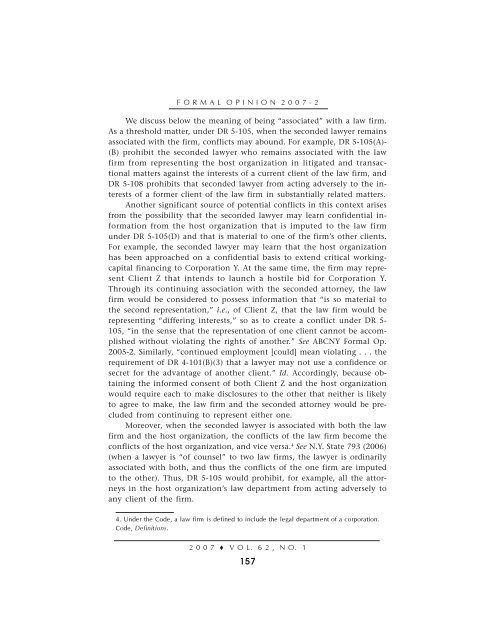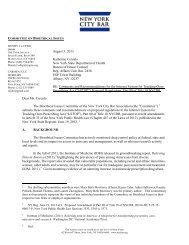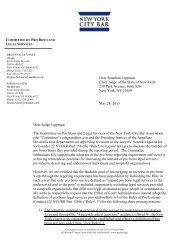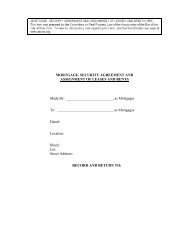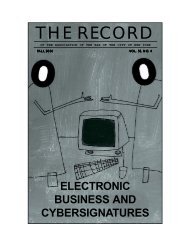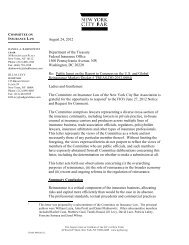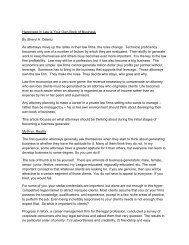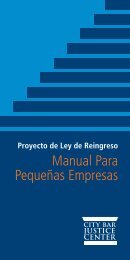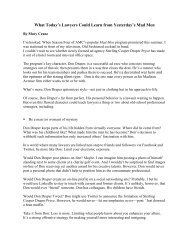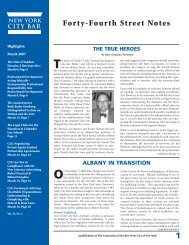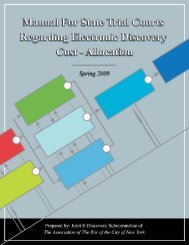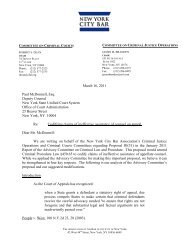2007 Issue 1 - New York City Bar Association
2007 Issue 1 - New York City Bar Association
2007 Issue 1 - New York City Bar Association
You also want an ePaper? Increase the reach of your titles
YUMPU automatically turns print PDFs into web optimized ePapers that Google loves.
F O R M A L O P I N I O N 2 0 0 7 - 2<br />
We discuss below the meaning of being “associated” with a law firm.<br />
As a threshold matter, under DR 5-105, when the seconded lawyer remains<br />
associated with the firm, conflicts may abound. For example, DR 5-105(A)-<br />
(B) prohibit the seconded lawyer who remains associated with the law<br />
firm from representing the host organization in litigated and transactional<br />
matters against the interests of a current client of the law firm, and<br />
DR 5-108 prohibits that seconded lawyer from acting adversely to the interests<br />
of a former client of the law firm in substantially related matters.<br />
Another significant source of potential conflicts in this context arises<br />
from the possibility that the seconded lawyer may learn confidential information<br />
from the host organization that is imputed to the law firm<br />
under DR 5-105(D) and that is material to one of the firm’s other clients.<br />
For example, the seconded lawyer may learn that the host organization<br />
has been approached on a confidential basis to extend critical workingcapital<br />
financing to Corporation Y. At the same time, the firm may represent<br />
Client Z that intends to launch a hostile bid for Corporation Y.<br />
Through its continuing association with the seconded attorney, the law<br />
firm would be considered to possess information that “is so material to<br />
the second representation,” i.e., of Client Z, that the law firm would be<br />
representing “differing interests,” so as to create a conflict under DR 5-<br />
105, “in the sense that the representation of one client cannot be accomplished<br />
without violating the rights of another.” See ABCNY Formal Op.<br />
2005-2. Similarly, “continued employment [could] mean violating . . . the<br />
requirement of DR 4-101(B)(3) that a lawyer may not use a confidence or<br />
secret for the advantage of another client.” Id. Accordingly, because obtaining<br />
the informed consent of both Client Z and the host organization<br />
would require each to make disclosures to the other that neither is likely<br />
to agree to make, the law firm and the seconded attorney would be precluded<br />
from continuing to represent either one.<br />
Moreover, when the seconded lawyer is associated with both the law<br />
firm and the host organization, the conflicts of the law firm become the<br />
conflicts of the host organization, and vice versa. 4 See N.Y. State 793 (2006)<br />
(when a lawyer is “of counsel” to two law firms, the lawyer is ordinarily<br />
associated with both, and thus the conflicts of the one firm are imputed<br />
to the other). Thus, DR 5-105 would prohibit, for example, all the attorneys<br />
in the host organization’s law department from acting adversely to<br />
any client of the firm.<br />
4. Under the Code, a law firm is defined to include the legal department of a corporation.<br />
Code, Definitions.<br />
2 0 0 7 V O L. 6 2 , N O. 1<br />
157


